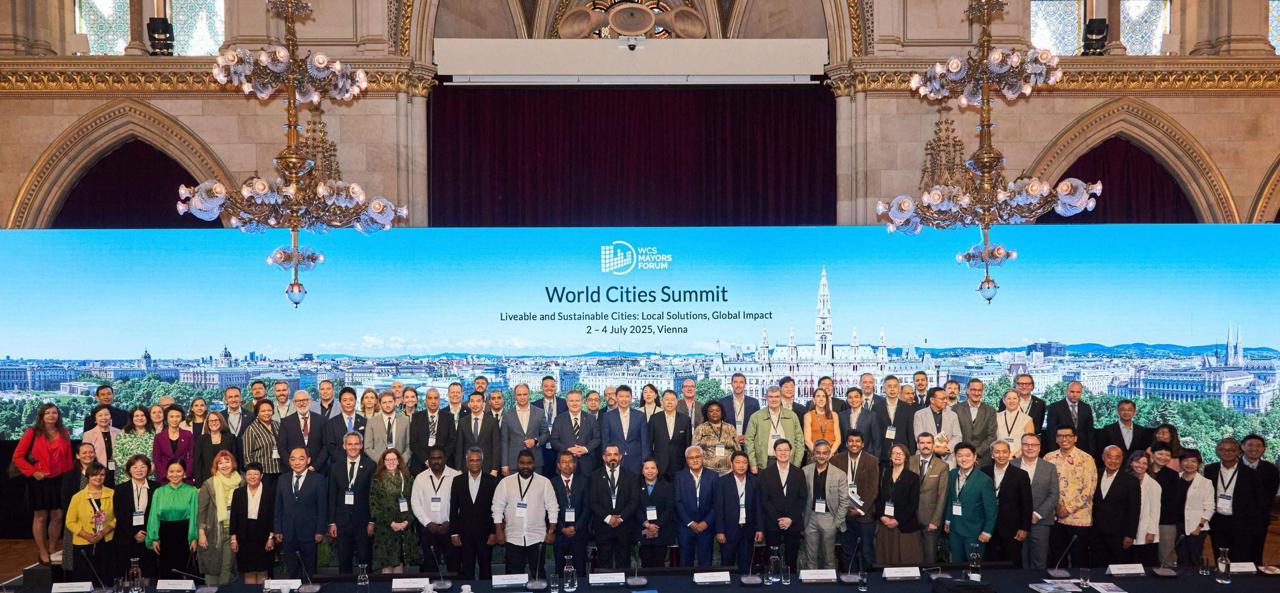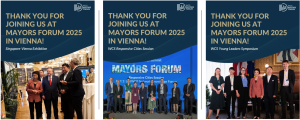
The International Urban and Regional Cooperation Asia & Australasia (IURC AA) accepted the invitation by Singapore’s Centre for Liveable Cities (CLC) and the Urban Redevelopment Authority (URA), to join as a strategic partner at the 14th Mayors Forum of the World Cities Summit 2025 (a flagship component of the World Cities Summit (WCS)) in Vienna, Austria from 2 to 4 July 2025. The Mayors Forum 2025 was guided by the theme “Liveable and Sustainable Cities: Local Solutions, Global Impact” and provided a useful platform to exchange ideas and solutions, to address pressing urban challenges, share best practices and foster stronger networks among city leaders around the world. A total of 62 cities from 39 countries were present. Pablo Gándara, IURC Team Leader for Asia and Australasia, expressed his gratitude to the CLC invitation as a special forum to meet with city leaders and technical experts from Europe, Asia and Australasia. “Participating at the Vienna Mayors Forum helps us to promote the ongoing call for EU cities and regions to join the IURC and to establish direct contacts with cities from Asia and Australasia that have already been selected for the upcoming phase. We look forward to cooperating with the CLC within the World Cities Summit 2026 in Singapore”, he said.
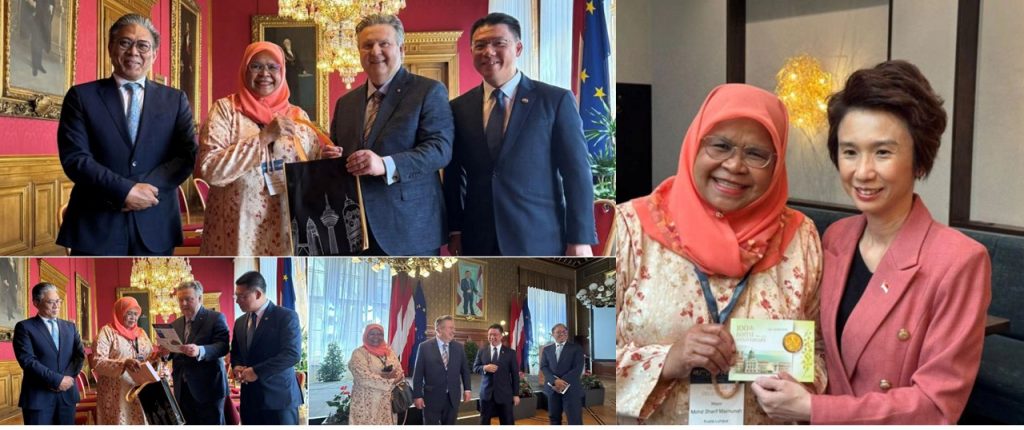
Some strategic partnerships were forged amongst the IURC cities network on key thematic cluster networks with the facilitation of Singapore’s Centre for Liveable Cities (CLC) and Singapore’s Urban Redevelopment Authority (URA). YBhg. Dato’ Seri Paduka TPr Dr. Maimunah Mohd. Sharif, Mayor of Kuala Lumpur was able to present the newly gazetted Kuala Lumpur Local Plan 2040 (KL2040) to her Viennese counterpart, Mayor Michael Ludwig, a significant milestone that reflects KL’s ambitions to lead in integrated, inclusive urban development. The session was made even more impactful by the presence of YB Kor Ming Nga, Minister of Housing and Local Government Malaysia who also attended the forum in his capacity as President of the UN-Habitat Assembly. His participation further reinforced Malaysia’s commitment to advancing urban diplomacy and global city collaboration. KL2040 outlines a bold roadmap for the capital city: protecting biodiversity, prioritizing sustainable mobility, promoting inclusive housing and integrating cultural heritage into the urban fabric. Mayor Maimunah highlighted Kuala Lumpur’s readiness to learn from Vienna’s exemplary housing strategies while preparing the city to host the ASEAN Mayors and Governors Meeting (MGMAC 2025) in August. This high-level dialogue in Vienna marks a powerful moment where Malaysia’s capital city enters the international conversation on the future of urban living with KL2040 as its blueprint.
Mayor of Kuala Lumpur also met with her Singaporean counterpart, Mayor Low Yen Ling, Mayor of South West District and Chairperson of the Mayors’ Committee of Singapore. The meeting reaffirmed Kuala Lumpur’s commitment to enhancing city-to-city collaboration and both mayors expressed a shared vision for a more inclusive and sustainable ASEAN, underlining the importance of cross-learning and regional cooperation to elevate the quality of life for citizens in both cities.
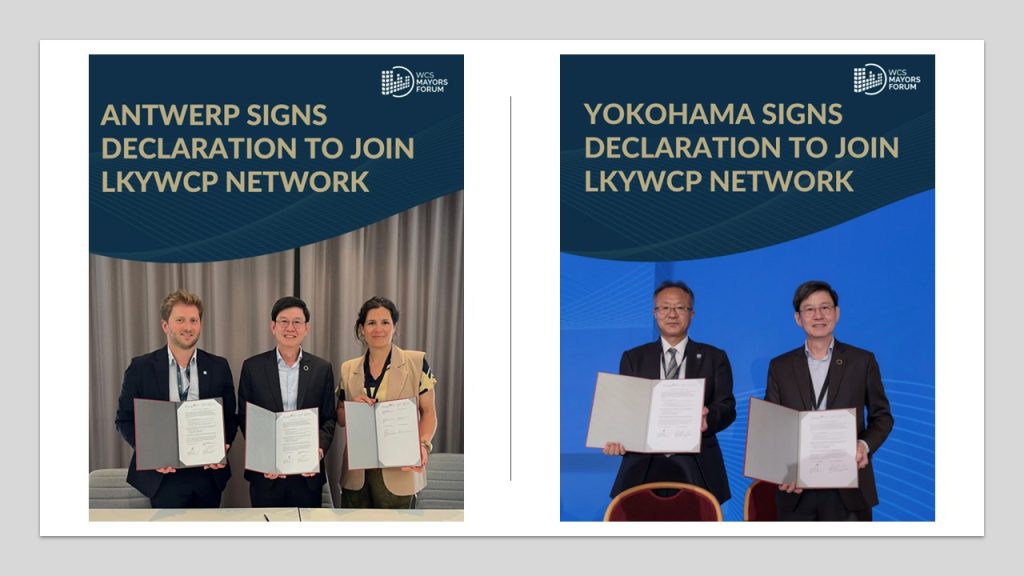
The city of Yokohama and city of Antwerp joined the City Network for the Lee Kuan Yew World City Prize. The declaration was signed by Mr. Ryoichiro Orii, Director-General of the City of Yokohama’s International Affairs Bureau, the Vice-Mayor for Sports, Worship Services and Animal Welfare Stijn De Rooster, Executive Director of Design Sciences Hub, University of Antwerp Jana Deforche, with Eng Hwee Lim, CEO of Urban Redevelopment Authority of Singapore (URA), in Vienna on 2 and 3 July 2025 respectively. The Design Sciences Hub on board as Antwerp’s Knowledge Organisation, reinforces the city’s commitment to collaborative urban solutions applying design thinking to solve complex urban and societal challenges through cross-disciplinary collaboration. Antwerp received the Special Mention accolade in 2020 for its careful and deliberate development of strategic projects over the long term to rejuvenate the city. The city was rejuvenated by tackling issues of climate change focusing on thematic cluster networks on affordable housing and living environments, urban mobility, and the strengthening of green and blue infrastructure. Key projects such as the revitalisation of the Scheldt Quays and the Urban Renewal Housing Programme were enabled by strong citizen engagement and cross-sector collaboration.
 Singapore’s Minister for National Development, Hong Tat Chee also shared how Singapore is strengthening the Prize’s City Network with two new initiatives:
Singapore’s Minister for National Development, Hong Tat Chee also shared how Singapore is strengthening the Prize’s City Network with two new initiatives:
💡 A new Research Fellowship will support research work on shared interests and challenges; the research findings will be shared with the wider global community.
💡 A special Urban Leaders Fellowship will offer attachment stints for city leaders to gain first-hand learning experiences in the City Network cities.
During the Mayoral Sessions and Responsive Cities Session, the sessions explored the increasingly complex challenges of rapid urbanisation including climate change and evolving societies. The representatives of 11 selected cities from the Lee Kuan Yew World City Prize Network member cities shared their cities approaches to urban governance, and how they are leveraging on science to encompass data-smart governance and use of technology in citizen engagements. They also shared how it has helped their cities to deliver evidence-based solutions to create urban environments that are more liveable, resilient, and attuned to the dynamic needs of the citizens. The session also brought together international research institutes, academic researchers and industry experts, and industry experts from fields of science of cities, urban planning, digital sector to share their insights on how cities are becoming more responsive through smart governance and use of innovative solutions to engage their citizens and address dynamic urban challenges.
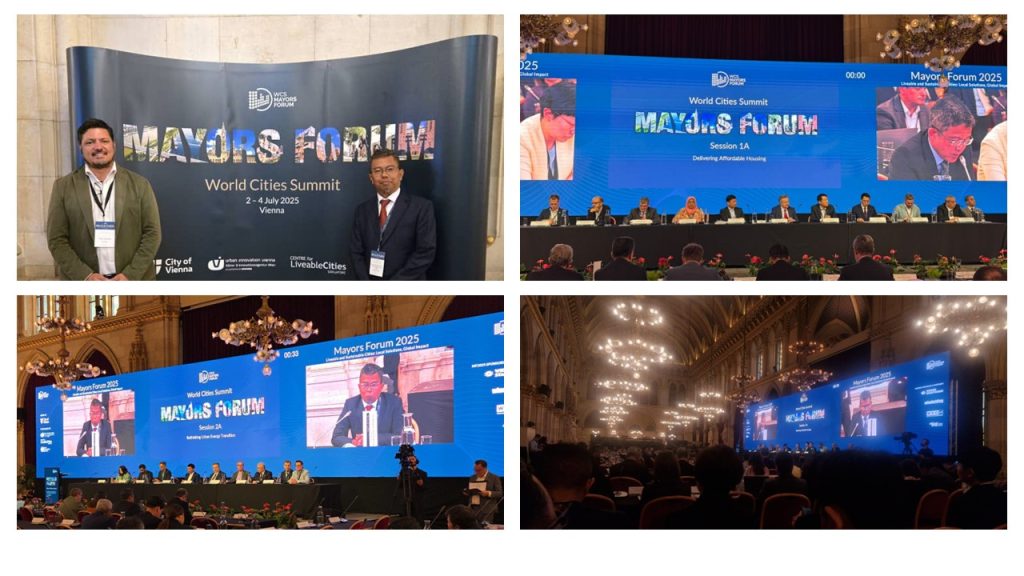
YBhg. Dato’ Hj Baderul Amin Bin Abdul Hamid, Mayor of Seberang Perai (IURC pilot city) said “Attending this forum has reinforced our belief that resilience is not just about bouncing back, it’s about bouncing forward. In Seberang Perai, we are addressing housing affordability through our Rent-to-Own scheme and mandatory quotas, ensuring inclusive development for all. Our Ampang Jajar Biogas Project shows how innovation and partnerships can turn waste into clean energy. We also recognize the urgent need for integrated smart systems and are investing in digital readiness while prioritizing data privacy and citizen outcomes. Learning from global peers on climate adaptation and nature-based solutions, we remain committed to building a city that is sustainable, inclusive, and future-ready.” The Mayor of Seberang Perai and Mayor of Kuala Lumpur was also part of the same panel together with Mayors from other countries and IURC member cities such as Mexico city, Brisbane, Bilbao, Seoul, Suzhou and other cities (London and Algiers) sharing their experiences and best practices.
Yang Berhormat Dato’ Haji Mohd. Noorazam bin Dato’ Haji Osman, Chief Executive of Iskandar Regional Development Authority (IURC pilot city), said that: “In Iskandar Malaysia, we believe that every city, large or small, has the power to lead by example; and when local solutions are scaled, adapted, and shared, they become a collective force for global resilience. The Mayors Forum helps us continue to work together to co-create cities that are not only smart and sustainable — but secure, inclusive, and future-ready”.
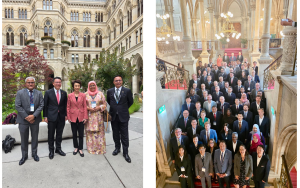
Site Visit: Delivering Affordable Housing – Ensuring accessibility through innovative policies and funding models (Thematic Cluster Network on Just and Inclusive)
City delegates were taken to Karl-Marx-Hof, a prominent example of early 20th-century social housing in Vienna, Austria. Completed in 1930, it was one of the largest housing complexes of its time and remains a significant architectural and historical landmark. One of the flagship projects of Vienna’s ambitious “Red Vienna” housing programme, it provided affordable and high-quality housing to the city’s working class. Beyond providing affordable apartments, municipal housing facilities included elements of social infrastructure including a library, washhouses, and kindergartens. Additionally, its expansive green spaces underscore the symbolic significance of the facility, creating an almost palace-like atmosphere.
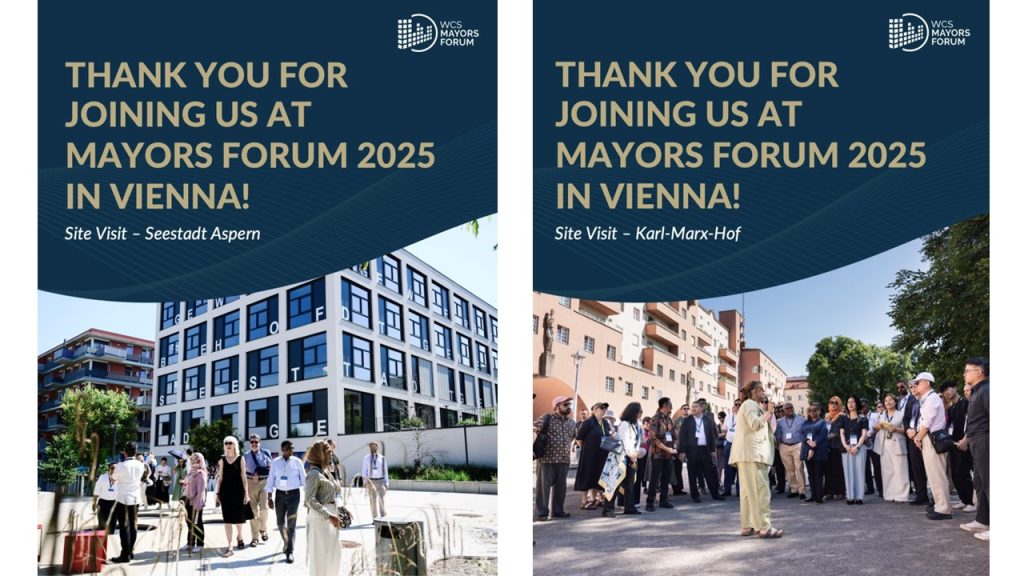
Seestadt Aspern (a business hub of international calibre) is one of Europe’s largest urban development projects whose design is centred around a water body. Located in Vienna’s fast-growing 22nd district in the north-east of the city, a new urban centre is taking shape – a smart city with a heart, designed to accommodate the whole spectrum of life. A multi-phase development of high-quality housing for over 25,000 people and, eventually, thousands of workplaces. Built on a foundation of innovative concepts and forward-looking ideas, this city-within-a-city combines high quality of life with economic drive with excellent transport links.
Nordbahnhof Quartier an urban development area for 20,000 people is leading the way with modern examples of affordable housing. This is an approximately 85-hectare freight yard area of the former North Railway Station, which is no longer required by the ÖBB (Austrian Federal Railways) for rail operations, and a new district has been gradually being built since the 1990s. “Bike City”, “Living at the Park” and “Bike & Swim” are some of the programmes that have been implemented here. In addition to the already built-up area around Rudolf-Bednar-Park and the Austria Campus, the last development areas “Wohnallee mit Bildungscampus” (Residential Avenue with Education Campus) and “Freie Mitte – Vielseitiger Rand” (Free Center – Versatile Edge) will be realized by 2026. The heart of the Nordbahnviertel is the “Freie Mitte” as a tangible urban wilderness – the central so-called “Gstett’n”, in which nature has regained its freedom between old track systems and historical buildings.
Site Visit: Delivering Flood Protection and Inner-City Recreational Area (Thematic Cluster Network on Green and Clean)
At the Danube Island, city delegates were able to learn how the 21-kilometer-long Danube Island is not only the favourite recreational region of the Viennese, but how it also functions as the city’s flood mitigation system. It showcases expansive network of trails inviting the athletically inclined to hike, jog, cycle and skate. Bathing areas with flat beaches as well as natural bathing sites, a water slide, a surfing school, a water ski lift and a boat rental service offer plenty of opportunities for fun on and in the water for residents.
Key takeaways: providing reliable and efficient municipal services requires enhancing good governance, applying technology and empowering communities. Collaborative cities in action also requires facilitating knowledge exchange, encouraging collaboration and deepening partnerships amongst cities through cities network.
- International Urban and Regional Cooperation Asia & Australasia (IURC AA)
Singapore’s Centre for Liveable Cities (CLC) alongside peers from Japan, Republic of Korea, Malaysia, Australia, New Zealand, India, People’s Republic of China, Hong Kong, Taiwan has been successfully selected under the EU-funded IURC Asia-Australasia programme.
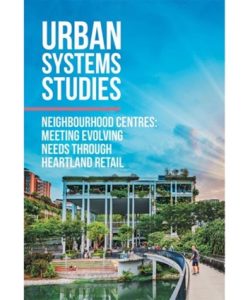 The CLC has also launched their latest in the series, “Urban System Studies: Neighbourhoods Centres” at the 2025 Mayors Forum of the World Cities Summit! It documents Singapore’s transformation into a liveable and sustainable city. Taking reference from the Singapore Liveability Framework, the series examines the interaction and integration of the policies, institutions and legislation that underpin Singapore’s urban development story, with key insights from leaders, policymakers and domain experts.
The CLC has also launched their latest in the series, “Urban System Studies: Neighbourhoods Centres” at the 2025 Mayors Forum of the World Cities Summit! It documents Singapore’s transformation into a liveable and sustainable city. Taking reference from the Singapore Liveability Framework, the series examines the interaction and integration of the policies, institutions and legislation that underpin Singapore’s urban development story, with key insights from leaders, policymakers and domain experts.
Access press coverage and social Media:
EIN Presswire, World Cities Summit, Lee Kuan Yee World City Prize, Centre for Liveable Cities and Urban Redevelopment Authority
For more information on EU–Singapore urban and regional cooperation, please contact Ms. Jacqueline Chang, Country Manager for Malaysia and Singapore and Cluster Manager for Circular Economy, at jchang@iurc.eu. She can connect you with relevant contacts at the Centre for Liveable Cities, Ministry of National Development.
